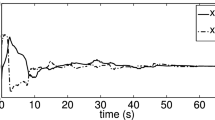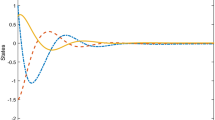Abstract
This paper is concerned with the non-fragile output feedback control problem for a class of interval type-2 (IT2) Takagi-Sugeno (T-S) fuzzy systems with mixed time-delays. The data transmission, which occurs in the sensor-to-controller channel, is scheduled by the round-robin protocol. At every transmission instant, the sensors can access the communication network and transmit signal to the corresponding controller in a fixed circular order. With the aid of Lyapunov theory, sufficient conditions are obtained to ensure the desired performance. Furthermore, the non-fragile H∞ controller is designed for a class of IT2 T-S fuzzy systems. The combination of orthogonal decomposition and linear matrix inequalities is implemented to deal with the nonlinear coupling terms in the gain solving process. Finally, a numerical example is employed to justify the practicality and effectiveness of the proposed control scheme.
Similar content being viewed by others
References
T. Takagi and M. Sugeno, “Fuzzy identification of systems and its applications to modeling and control,” IEEE Transactions on Systems, Man, and Cybernetics, vol. SMC-15, no. 1, pp. 116–132, 1985.
K. Tanaka and M. Sugeno, “Stability analysis and design of fuzzy control systems,” Fuzzy Sets and Systems, vol. 45, no. 2, pp. 135–156, 1992.
F. Cuesta, F. Gordillo, J. Aracil, and A. Ollero, “Stability analysis of nonlinear multivariable Takagi-Sugeno fuzzy control systems,” IEEE Transactions on Fuzzy Systems, vol. 7, no. 5, pp. 508–520, 1999.
Z. Cao, Y. Niu, H.-K. Lam, and J. Zhao, “Sliding mode control of Markovian jump fuzzy systems: A dynamic event-triggered method,” IEEE Transactions on Fuzzy Systems, vol. 29, no. 10, pp. 2902–2915, October 2021.
W. Xie, C. C. Lim, J. Zhang, and L. Huang, “New approaches to observer design and stability analysis for T-S fuzzy system with multiplicative noise,” Journal of the Franklin Institute, vol. 354, no. 2, pp. 887–901, 2017.
B. Huo, S. Tong, and Y. Li, “Observer-based adaptive fuzzy fault-tolerant output feedback control of uncertain nonlinear systems with actuator faults,” International Journal of Control, Automation, and Systems, vol. 10, no. 6, pp. 1119–1128, 2012.
H. Zhang, S. Sun, C. Liu, and K. Zhang, “A novel approach to observer-based fault estimation and fault-tolerant controller design for T-S fuzzy systems with multiple time delays,” IEEE Transactions on Fuzzy Systems, vol. 28, no. 8, pp. 1679–1693, August 2020.
Y. Zhao, J. Lam, and H. Gao, “Fault detection for fuzzy systems with intermittent measurements,” IEEE Transactions on Fuzzy Systems, vol. 17, no. 2, pp. 398–410, 2009.
D. Zhai, L. An, and J. Li, “Finite frequency fault detection for T-S fuzzy singular multiple time-delay systems,” International Journal of Control, Automation, and Systems, vol. 14, no. 4, pp. 977–985, 2016.
Z. Zhang, Y. Niu, and H. R. Karimi, “Sliding mode control of interval type-2 fuzzy systems under round-robin scheduling protocol,” IEEE Transactions on Systems, Man, and Cybernetics: Systems, vol. 51, no. 12, pp. 7602–7612, 2021.
J. M. Mendel, “General type-2 fuzzy logic systems made simple: A tutorial,” IEEE Transactions on Fuzzy Systems, vol. 22, no. 5, pp. 1162–1182, 2014.
C. Arino and A. Sala, “Extensions to “Stability analysis of fuzzy control systems subject to uncertain grades of membership”,” IEEE Transactions on Systems, Man and Cybernetics, Part B (Cybernetics), vol. 38, no. 2, pp. 558–563, 2008.
X. Tang, L. Deng, and H. Qu, “Predictive control for networked interval type-2 T-S fuzzy system via an event-triggered dynamic output feedback scheme,” IEEE Transactions on Fuzzy Systems, vol. 27, no. 8, pp. 1573–1586, 2019.
M. Wang, G. Feng, H. Yan, J. Qiu, and H. Zhang, “Membership-function-dependent fault detection filtering design for interval type-2 T-S fuzzy systems in finite frequency domain,” IEEE Transactions on Fuzzy Systems, vol. 29, no. 9, pp. 2760–2773, September 2021.
H. K. Lam, H. Li, C. Deters, E. L. Secco, H. A. Wurdemann, and K. Althoefer, “Control design for interval type-2 fuzzy systems under imperfect premise matching,” IEEE Transactions on Industrial Electronics, vol. 61, no. 2, pp. 956–968, 2014.
H. Divya, R. Sakthivel, S. A. Karthick, and C. Aouiti, “Non-fragile control design for stochastic Markov jump system with multiple delays and cyber attacks,” Mathematics and Computers in Simulation, vol. 192, pp. 291–302, 2022.
G. Yang, J. Wang, and C. Lin, “\({{\cal H}_\infty }\) control for linear systems with additive controller gain variations,” International Journal of Control, vol. 73, no. 16, pp. 1500–1506, 2000.
Z. Li, Z. Wang, D. Ding, and H. Shu, “Non-fragile H∞ control with randomly occurring gain variations, distributed delays and channel fadings,” IET Control Theory and Applications, vol. 9, no. 2, pp. 222–231, 2015.
Y. Liu and Y. Ma, “Finite-time non-fragile extended dissipative control for T-S fuzzy system via augmented Lyapunov-Krasovskii functional,” ISA Transactions, vol. 117, pp. 1–15, 2021.
W. Che and G. Yang, “Non-fragile dynamic output feedback H∞ control for discrete-time systems with FWL consideration,” International Journal of Control, Automation, and Systems, vol. 9, no. 5, pp. 993–997, 2011.
F. Shu, M. Li, and D. Liu, “Non-fragile H∞ control for Markovian jump fuzzy systems with time-varying delays,” Physica A: Statistical Mechanics and its Applications, vol. 525, no. 1, pp. 1177–1191, 2019.
B. Zhang, S. Zhou, and T. Li, “A new approach to robust and non-fragile H∞ control for uncertain fuzzy systems,” Information Sciences, vol. 177, no. 22, pp. 5118–5133, 2007.
L. Zou, Z. Wang, and H. Gao, “Observer-based \({{\cal H}_\infty }\) control of networked systems with stochastic communication protocol: The finite horizon case,” Automatica, vol. 63, pp. 366–373, 2016.
J. Song, Z. Wang, and Y. Niu, “Static output-feedback sliding mode control under round-robin protocol,” International Journal of Robust and Nonlinear Control, vol. 28, no. 18, pp. 5841–5857, 2018.
D. Ding, Z. Wang, Q. Han, and G. Wei, “Neural-network-based output-feedback control under round-robin scheduling protocols,” IEEE Transactions on Cybernetics, vol. 49, no. 6, pp. 2372–2384, 2019.
L. Zou, Z. Wang, H. Gao, and X. Liu, “State estimation for discrete-time dynamical networks with time-varying delays and stochastic disturbances under the round-robin protocol,” IEEE Transactions on Neural Networks and Learning Systems, vol. 28, no. 5, pp. 1139–1151, 2017.
L. Nie, D. Chen, and J. Hu, “Quantized sliding mode control for networked Markovian jump systems under round-robin protocol: The output feedback case,” International Journal of Control, Automation, and Systems, vol. 10, pp. 2674–2686, 2021.
Y. Wang, Z. Wang, L. Zou, and H. Dong, “H∞ PID control for discrete-time fuzzy systems with infinite-distributed delays under round-robin communication protocol,” IEEE Transactions on Fuzzy Systems, vol. 30, no. 6, pp. 1875–1888, 2022.
K. Liu, E. Fridman, and L. Hetel, “Stability and L2-gain analysis of networked control systems under round-robin scheduling: A time-delay approach,” Systems & Control Letters, vol. 61, no. 5, pp. 666–675, 2012.
V. Ugrinovskii and E. Fridman, “A round-robin type protocol for distributed estimation with \({{\cal H}_\infty }\) consensus,” Systems & Control Letters, vol. 69, pp. 103–110, 2014.
D. Yue and J. Lam, “Non-fragile guaranteed cost control for uncertain descriptor systems with time-varying state and input delays,” Optimal Control Applications and Methods, vol. 26, no. 2, pp. 85–105, 2005.
Q. Zhong, J. Yang, K. Shi, S. Zhong, Z. Li, and M. A. Sotelo, “Event-triggered H∞ load frequency control for multi-area nonlinear power systems based on non-fragile proportional integral control strategy,” IEEE Transactions on Intelligent Transportation Systems, vol. 23, no. 8, pp. 12191–12201, 2022.
Z. Wang, F. Yang, D. W. C. Ho, and X. Liu, “Robust variance-constrained H∞ control for stochastic systems with multiplicative noises,” Journal of Mathematical Analysis and Applications, vol. 328, no. 1, pp. 487–502, 2007.
S. Boyd, L. Ghaoui, E. Feron, and V. Balakrishnan, Linear Matrix Inequalities in Systems and Control Theory, Society for Industrial and Applied Mathematics, Philadelphia, PA, USA, 1994.
D. Zhao, Z. Wang, G. Wei, and X. Liu, “Non-fragile H∞ state estimation for recurrent neural networks with time-varying delays: On proportional-integral observer design,” IEEE Transactions on Neural Networks and Learning Systems, vol. 32, no. 8, pp. 3553–3565, August 2021.
J. Dong and G. Yang, “Robust static output feedback control for linear discrete-time systems with time-varying uncertainties,” Systems & Control Letters, vol. 57, no. 2, pp. 123–131, 2008.
Z. Zhang, Y. Niu, Z. Cao, and J. Song, “Security sliding mode control of interval type-2 fuzzy systems subject to cyber attacks: The stochastic communication protocol case,” IEEE Transactions on Fuzzy Systems, vol. 29, no. 2, pp. 240–251, 2021.
Q. Lu, P. Shi, H. K. Lam, and Y. Zhao, “Interval type-2 fuzzy model predictive control of nonlinear networked control systems,” IEEE Transactions on Fuzzy Systems, vol. 23, no. 6, pp. 2317–2328, 2015.
Author information
Authors and Affiliations
Corresponding author
Additional information
Publisher’s Note
Springer Nature remains neutral with regard to jurisdictional claims in published maps and institutional affiliations.
This work was supported in part by the National Natural Science Foundation of China (61603255) and the Shanghai Twilight Program of China (18CG52).
Sunjie Zhang received his B.Sc. degree in applied mathematics from Donghua University, Shanghai, China, in 2010, and a Ph.D. degree in control theory and control engineering from Donghua University, Shanghai, China, in 2015. From May 2015 to September 2017, he was a postdoctoral researcher with the postdoctoral research station of Optical Engineering, University of Shanghai for Science and Technology, Shanghai, China. He is currently a lecturer with the Department of Control Science and Engineering, University of Shanghai for Science and Technology, Shanghai, China. His research interests include nonlinear stochastic control and filtering, as well as complex networks. He is a reviewer for some international journals.
Yi Yang received her B.S. degree in mathematics and applied mathematics from Henan Institute of Science and Technology, Henan, China, in 2019. She is currently working toward an M.S. degree from the Department of Operations Research and Cybernetics, University of Shanghai for Science and Technology, Shanghai, China. Her current research interests include fuzzy control and nonlinear control.
Rights and permissions
About this article
Cite this article
Zhang, S., Yang, Y. Non-fragile Control for Interval Type-2 T-S Fuzzy Systems with Mixed Time-delays Under Round-robin Protocol. Int. J. Control Autom. Syst. 20, 3759–3770 (2022). https://doi.org/10.1007/s12555-021-0659-y
Received:
Revised:
Accepted:
Published:
Issue Date:
DOI: https://doi.org/10.1007/s12555-021-0659-y




